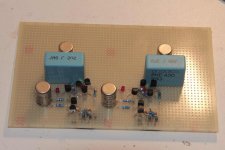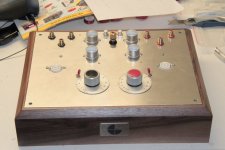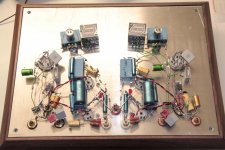Love Tal Wilkenfeld... gave me chills this one.. thanks for sharing
she is great . Not only a pretty face , that's for sure.
Attachments
I want to ask for a opinion. I am working in a voltage amplifier circuit without global feedback similar to the one Damir is doing, and I manage to have a gain of 80 with only 0.0004% dist. with 8V p-p at output,but I was wonder , if it could be good for a phono amplifier. what is the gain necessary for that function?
80 dB is a little low, I personally would like to want 85-86 to make a phone with 65 dB at 1KHz, as you have 8V sving your circuit may have enough overload margin to handle 65 dB gain, option could be to double the transistors in the output current mirror as to up the gain by 6 db, and to increase voltage rails a bit to, to maintain the overload margin. of course the clicks and pops are placed higher in the frequency spectra, so over-load may not be an issue but still I would like to have 65-66 dB gain and a healthy output buffer to (like the Calvin) to be able to avoid a pre-amp with gain in the system.
Last edited:
In theory, a soft clipper (resistor series to inversely parallel diodes series to tiny cap) inside an inverting amplifier, could reduce gain of the loudest clicks and pops transparently, without activating for valid signal. Not unlike this concept (except with an amp more suited to phonograph than tracer): http://www.diyaudio.com/forums/atta...ge-battery-operated-amplifier-tracerphone.gif There's a caveat of adjusting the gain to fit the soft clipper action though. And the concept works whenever the diode clip isn't as loud as the noise it is assigned to reduce. So, it should only reduce clicks and pops that are louder than normal music signal. Very low capacitance diodes are fair for this use, such as BAT diodes or little silicon small signal diodes could be used. However, InGan materials semiconductor is much more interesting since it reacts to squares harder than sines, so that a white LED is an almost smart filter. I wonder if there's a low capacitance InGan (or similar material) transistor available? A high voltage, low capacitance small size soft recovery fast silicon diode might could be used for the job.
Last edited:
Thanks Ricardo and MiiB. 86db gain is quite high. Maybe with two amplifiers with a gain of 140 each . I will see what I can do , but please do not have great expectations , as I have others priorities , I will not post the circuit because it is not yet optimal , but will be similar with others I have already post in Damir thread .
I think the paradise oneshot Riaa is quite successful and very close to optimum, I have made a phono stage using your circuit as well, well actually two of them, one single ended (humbugger balanced) and one fully balanced with two current input stages and the humbugger raised to 1K then the two inputs are criss crossed into the input. I just would love to see your concept with more gain, so the split Riaa two gainstage compensation could be avoided and it could be possible to work one shot current vise like on the paradise.... ohh well that may just a dream... BTW i don't mind a capacitor current output.. as opposed to mirror the signal out through more transistors. my experiences with your circuit is that i don't see any loss by using a capped current tap.
I did not post much recently but i am as busy as always.
I got a very good soundind AT140ML PCOCC with Shibata needle so i decided to make some MM stages. One is solid state and the other is tube. The tube stage also has a line stage inbuild. I plan to show it on ETF. There is a phono stage competition that allows only coils and resistors in the RIAA. My stage has caps and resistors so i can not officially compete. Anyway, i am curious how that comes out.
I got a very good soundind AT140ML PCOCC with Shibata needle so i decided to make some MM stages. One is solid state and the other is tube. The tube stage also has a line stage inbuild. I plan to show it on ETF. There is a phono stage competition that allows only coils and resistors in the RIAA. My stage has caps and resistors so i can not officially compete. Anyway, i am curious how that comes out.




